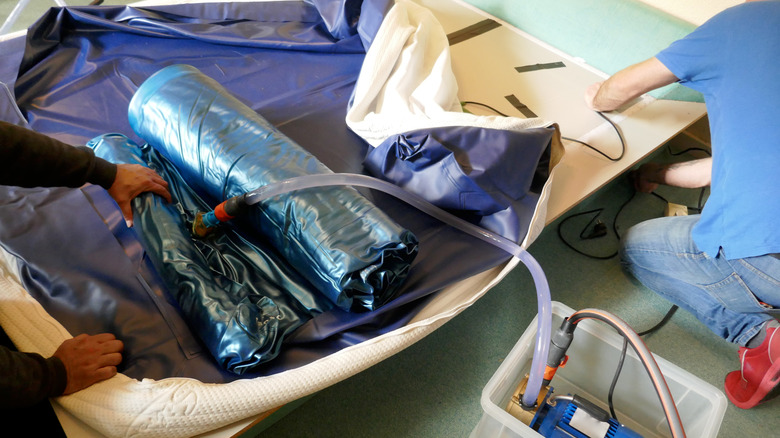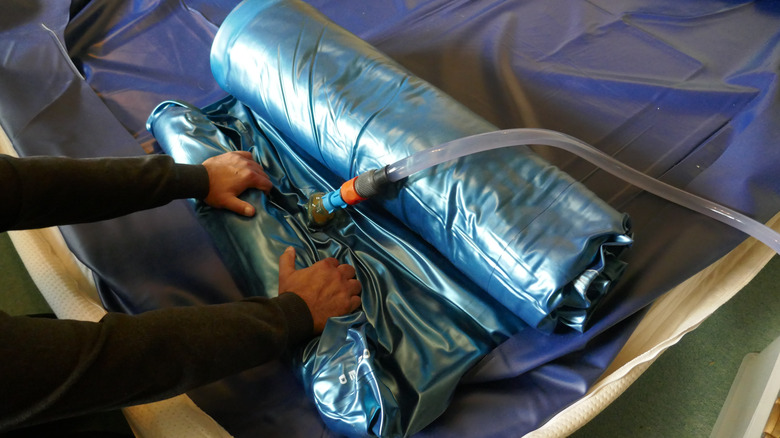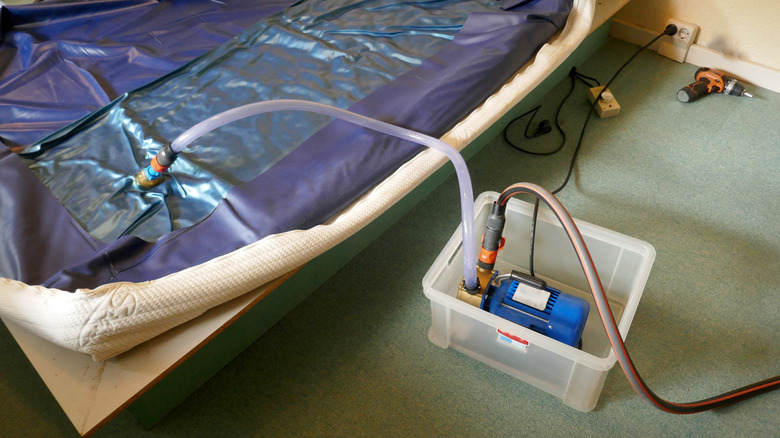3 Important Things To Consider Before Getting A Waterbed
If you were born in the 1980s or thereabouts, you'll remember the obsession with waterbeds. For the younger crowd, yes, it was that big of a deal. Yet the 1990s and early 2000s saw a decline in the thirst for waterbeds (pun intended) and people stopped buying them. Was it merely a fad? Maybe yes, maybe no. But they're still out there and if you've decided for whatever reason to get a waterbed, you're in the right place.
True to their name, waterbeds have mattresses that are made of vinyl and filled with water as opposed to springs and foam. They come in two major types (hardside and softside), and most models come with temperature regulation. Sounds luxurious, doesn't it? According to the experts at Purple, a waterbed can run you anywhere from $500 to $2,000. If you wind up paying towards the higher end for a bed, you need to get value for money. So today, we've compiled an A-list guide for three important things to know before getting a waterbed: maintenance, some pros, and a few cons. Weighing this information will help you decide if purchasing a waterbed is the right investment for you.
Waterbed maintenance
First things first, let's review those two types of waterbeds: hardside and softside. According to Nectar Sleep, a hardside waterbed has an external wooden frame that is responsible for its setup and structure. The vinyl mattress which contains the water, called a bladder, is placed inside the wooden structure. Easy peasy. The softside waterbed, on the other hand, has a structure of foam bolsters coated with a fabric casing. Reviews say that this creates a more comfortable surface, especially for people who experience chronic body pain.
To maintain either of these waterbeds, consistency is key. According to Each Night, a high quality, properly maintained waterbed can last as long as 20 years, so it's worth the work. First, you'll occasionally have to refill the bladder. If you have a king-size bed, that's roughly 235 gallons of water, and the easiest way to get this task done is with a garden hose.
To help against wear and tear, Nectar Sleep writes that waterbed conditioners are important to add once per year. Other maintenance routines typically include a periodic check for leaks and scheduling an immediate fix if you find any. Finally, keep in mind that if you ever have to move your waterbed for any reason, you'll first need to drain it out completely.
Pros of the waterbed
What is in it for you if you decide to get a waterbed anyway? Well, the first selling point is that they are known for being immensely comfortable. Our money is on the fact that water tends to shape shift to the needs of the human body, unlike an average mattress. The presence of heaters in waterbeds makes them even more desirable. Carbon Heater writes that you could make your bed warmer when necessary and adjust it cooler when you prefer.
Another benefit of the waterbed is that the vinyl surface is resistant to stains. If you have a kid, a pet, or just tend to be a little clumsy with food and drink, you need not soil your mattress. A regular waterbed is super easy to clean. Just wipe off the dirt with a wet cloth and you'll be good to go.
Finally, because there's no risk of bedsores, waterbeds are an ideal choice for patients with illnesses that cause them to be paralyzed or bedridden. The comfort levels are top tier and just what they need (via Early Bird by Amerisleep).
Cons of the waterbed
Why did the waterbed fall out of popularity in the late 1990s? Well, reviewing the cons might just help you see why. The first thing that people couldn't stand was the risk of leaks. Maintaining a waterbed could be likened to walking across a minefield for fear of pops and, ultimately, leaks. Water leaks can lead to a buildup of mold, which is a serious health hazard.
According to Mattressnut another major con of the waterbed is that, unlike king-sized regular mattresses or memory foams that weigh only around 150 pounds, a full waterbed can weigh as much as 2,000 pounds! Not only does this make moving difficult, it could have structural implications for your home or apartment as well.
Finally, most people have found the waterbed needlessly expensive. Like we mentioned earlier, a standard waterbed can cost as much as $2,000, whereas memory foams can be more like $300 at a retailer like Overstock, and they'll spare you the fear of leaks.



